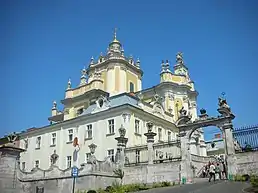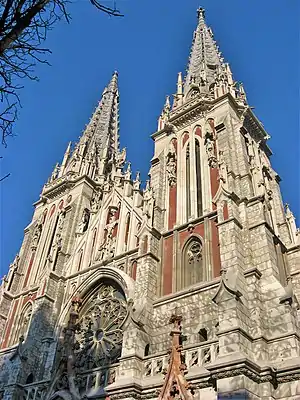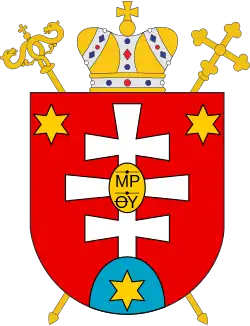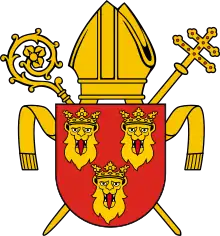Catholic Church in Ukraine
The Catholic Church in Ukraine (Latin: Ecclesia Catholica in Ucraina; Ukrainian: Католицька церква в Україні) is part of the worldwide Catholic Church, under the spiritual leadership of the Pope in Rome.
Catholic Church in Ukraine | |
|---|---|
 | |
| Type | National polity |
| Classification | Catholic |
| Orientation | European |
| Polity | Episcopal |
| Pope | Pope Francis |
| Major Archbishop (UGCC) | Sviatoslav Shevchuk |
| Archbishop (Latin) | Mieczysław Mokrzycki |
| Bishop (RGCC) | Nil Lushchak (Apostolic administrator) |
| Region | Ukraine |
| Language | Greek, Ukrainian |
| Part of a series on the |
| Catholic Church by country |
|---|
.svg.png.webp) |
|
|

The majority of Catholics in Ukraine belong to the Ukrainian Greek Catholic Church, while significant numbers of others belong to the Latin Church (known as Roman Catholic), Ruthenian Greek Catholic Church, or Armenian Catholic Church.
Types of Catholic churches by rite
History and data
The Catholic Church in Ukraine consists of members of the Ukrainian Greek Catholic Church as well as the Roman (Latin Rite) Catholic Church in Ukraine, Ruthenian Catholic Church, and the Armenian Catholic Church.
The majority of Ukrainian Catholics belong to the Ukrainian Greek Catholic Church. The Roman Catholic Church in the territories of modern Ukraine has been strongly associated with Poland and Poles, but the church has emphasized a Ukrainian identity since the nation's independence from the Soviet Union.
The history of the Catholic Church in modern Ukraine starts as early as the 10th century when Christianity in Ruthenia was established as a state religion in 988 taking place before the East–West Schism. While records of Christians and Christian temples in the Medieval state predate the date. In mid 10th century Kyiv was visited by a mission that was led by bishop Adalbert of Magdeburg out of Trier Monastery. Following the schism, the Ruthenian Church which was brought to Kyiv by the Byzantine Greeks ended up among Eastern Orthodox Churches. After annexation of the Kingdom of Ruthenia by the Kingdom of Poland in course of the Galicia–Volhynia Wars in Lviv was established the Roman Catholic Archdiocese of Lviv in the 14th century. In mid 15th century Metropolitan of Kyiv Isidore attempted to unite the Ruthenian Church with the Catholic world by attending the Council of Florence.
Due to the conflict with the Grand Duchy of Moscow, in 1458 the Ecumenical Patriarch of Constantinople Isidore II reorganized the Ruthenian Church moving its metropolitan see to Vilnius. Until 1480 the metropolitan see of the Church was held by a metropolitan bishop appointed by the Pope including Gregory the Bulgarian and Misail Pstruch. In 1595 there was signed the Union of Brest which officially united the Ruthenian Church with the Catholic Church accomplishing the intent of Metropolitan Isidore. Following partitions of Poland, in 1839 in Polotsk pressured by the Russian government most of bishops of the Ruthenian Uniate Church signed the union with the Patriarchate of Moscow, while diocese that became part of the Austrian Empire were reorganized as Greek-Catholic Church.
In 1630 a bishop of Armenian Apostolic Church Mikołaj Torosowicz also signed a union with the Catholic Church establishing Armenian Catholic diocese of Lwow.
In 1646 another Eastern Orthodox diocese of Mukachevo signed the Union of Uzhhorod and for sometime was guided by the Archbishop of Eger in Hungary.
In 2001, Ukraine was visited by Pope John Paul II, who held official and informal meetings in Kyiv and Lviv.[1] Obviously the Ukrainian Greek Catholic Church and the Latin Church in the country warmly greeted a visit from their spiritual father. Non-Catholic religious communities expressed hope that the visit would encourage a spiritual and cultural renewal in a country troubled by economic and social problems.[2]
Catholic charity Caritas Spes (by 2007 information) functions in 12 regions of the country, has 40 centers engaging 500 employees and volunteers.[3] It runs six family-style homes for orphans with 60 children, financed health rehabilitation camps situated in environmentally healthful areas around Kyiv, Zhytomyr, Ivano-Frankivsk, and Transcarpathian regions, benefits 2,500 children each year. About 12,000 Ukrainian children, mainly victims of Chernobyl, orphans, and children from poor families, had their health improved in this way in 2002–2007.[3]
In 2005 the number of Catholics was estimated at around 4 million 760 thousand people, which represents 7.3% of the population. Of these, about 4 million are Greek Catholics, and 500-800 thousand Catholics of the Latin rite. There is also a small Armenian Catholic community, although before the Second World War the number of Armenian Catholics in Lviv was significant. A characteristic feature of Ukrainian Catholicism is the predominance of Greek Catholic believers over Latin Catholics. Ukraine is the only country in Europe where Catholics of the Eastern rite prevail over Roman Catholics
Ukrainian Greek Catholic Church
The Ukrainian Greek Catholic Church is a Byzantine Rite Eastern Catholic Church in full communion with the Holy See. The ordinary (or hierarch) of the church holds the title of Major Archbishop of Kyiv-Halych and All Ruthenia, though the hierarchs and faithful of the church have acclaimed their ordinary as "Patriarch" and have requested Papal recognition of, and elevation to, this title. Major archbishop is a unique title within the Catholic Church that was introduced in 1963 as part of political compromise. Since March 2011 the head of the church is Major Archbishop Sviatoslav Shevchuk.
Latin Catholic Church in Ukraine

The present Archbishop for the Latins is Mieczysław Mokrzycki (ordained on 29 September 2007 by Pope Benedict XVI).[4]
The Latin Church in Ukraine had in 2007 905 communities, 88 monasteries, 656 monks and nuns, 527 priests, 713 churches (74 under construction), 39 missions, 8 educational institutions, 551 Sunday schools, 14 periodical editions.[5][6]
Latin Catholic cathedrals in Ukraine
- Sts. Peter and Paul Cathedral, in Kamyanets-Podilsky
- Cathedral of the Assumption of the Blessed Virgin Mary in Kharkiv
- Merciful Father Co-Cathedral, in Zaporizhia
- Saint Sophia Cathedral, in Zhytomyr
- St. Alexander Co-Cathedral, in Kyiv
- Sts. Peter and Paul Cathedral, in Lutsk
- Archcathedral Basilica of the Assumption of the Blessed Virgin Mary, in Lviv
- Cathedral of St. Martin of Tours, in Mukacheve
- Assumption of the Blessed Virgin Mary Cathedral, in Odesa.[7]
Hierarchy
See also
References
- Ukraine Remembers Visit of John Paul II, Zenit News Agency, June 2006
- Ukraine responds to the Papal Visit, Religious Information Service of Ukraine
- Sixteen Years a Short Period to Learn the Charity Habit, Interview with Caritas-Spes Head of Ukraine, RISU Portal, September 2007
- Catholic Hierarchy Portal News
- Parafiyalna Gazeta (Roman Catholic newspaper), N 24, December, 2007, in Ukrainian
- Roman Catholicism in Ukraine, Religious Information Service of Ukraine web-site
- GCatholic Directory


